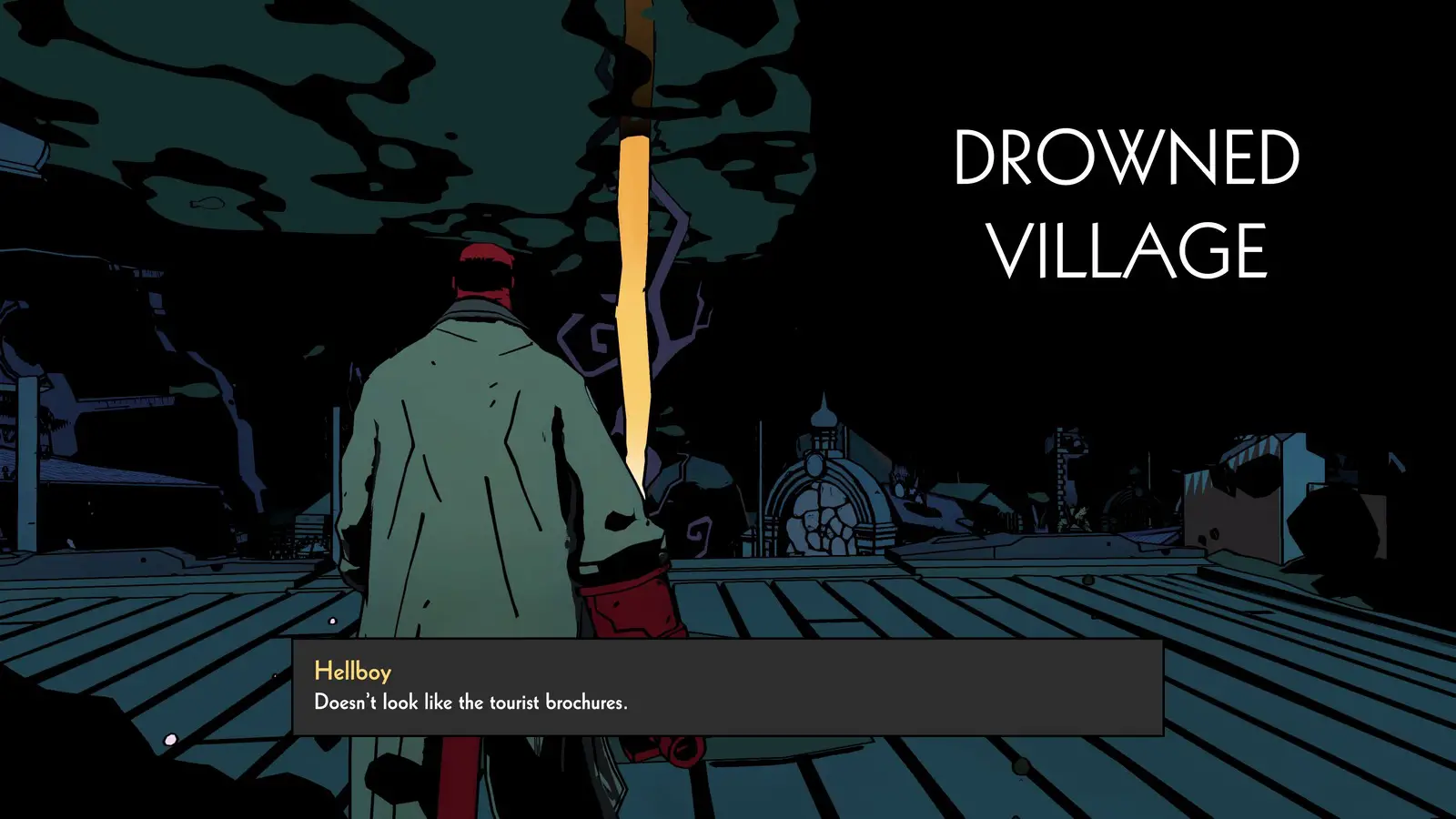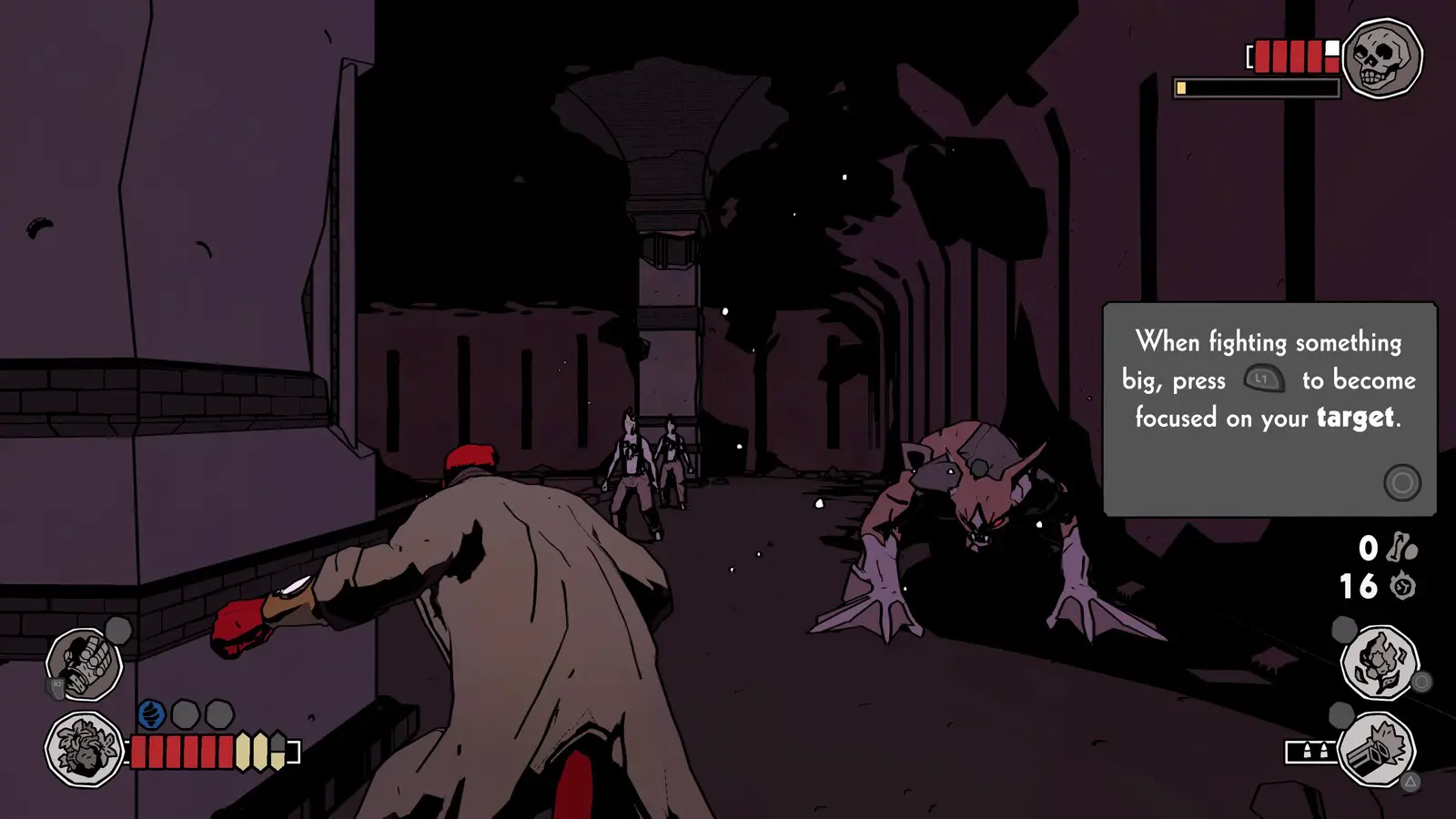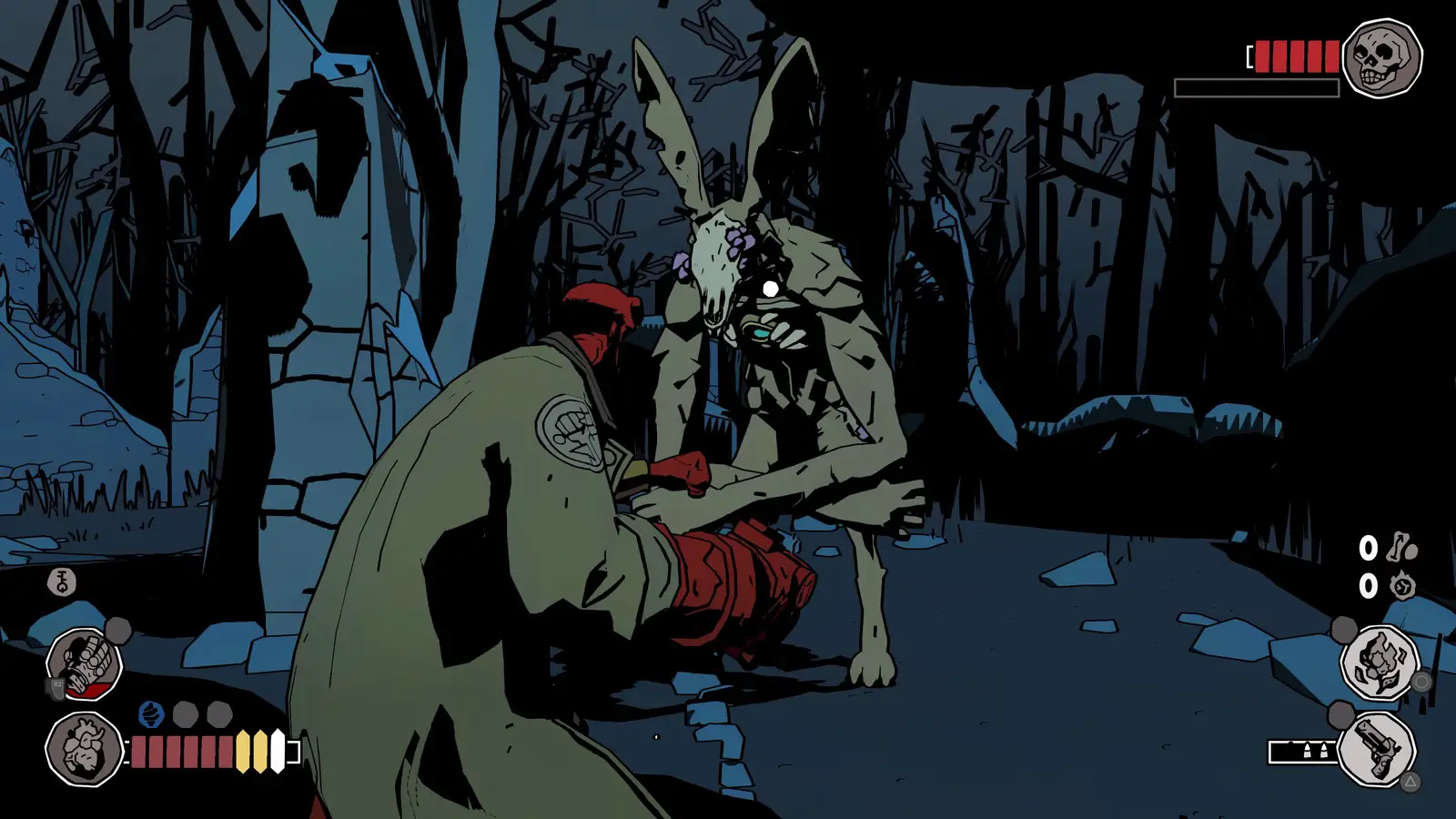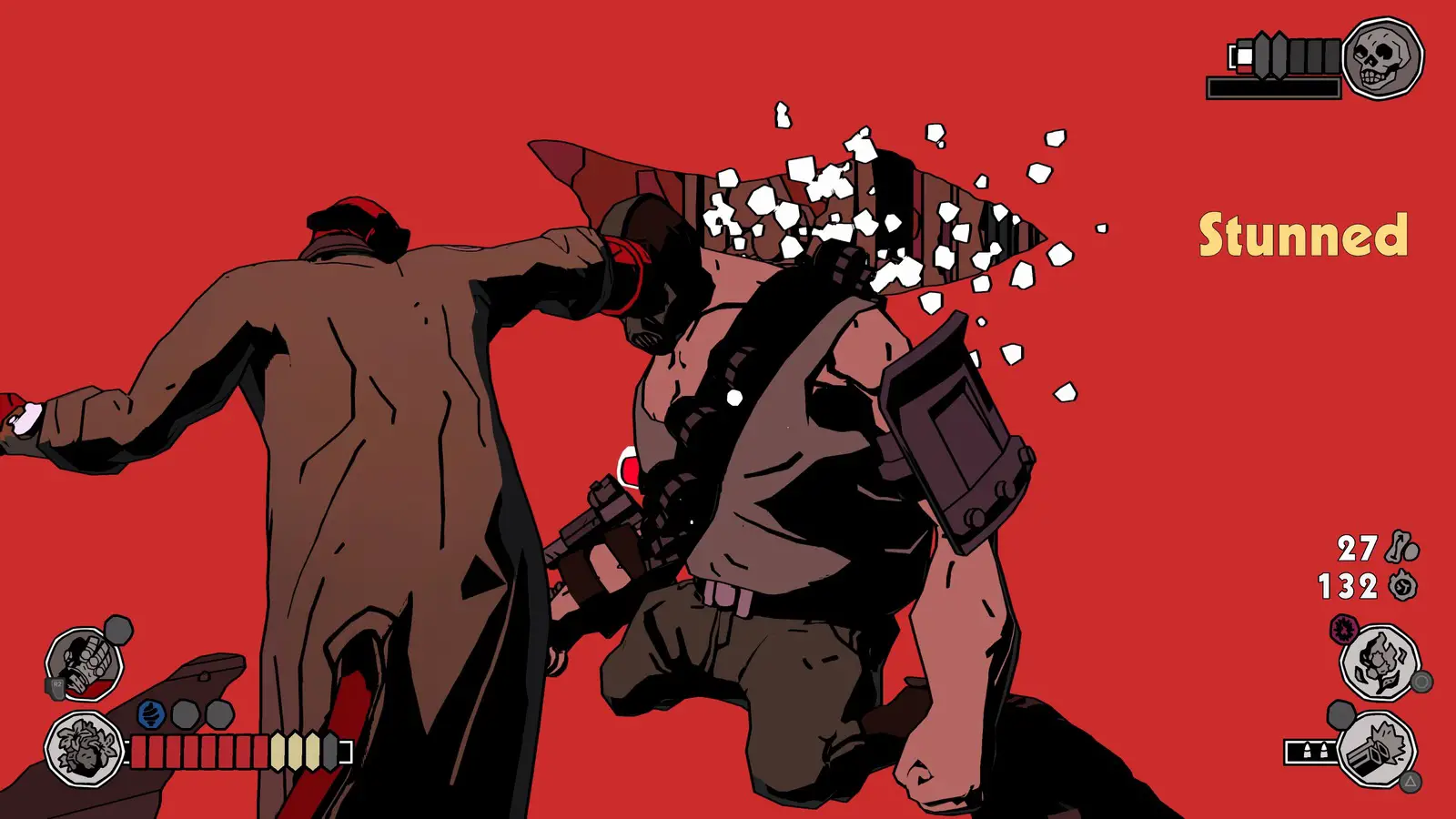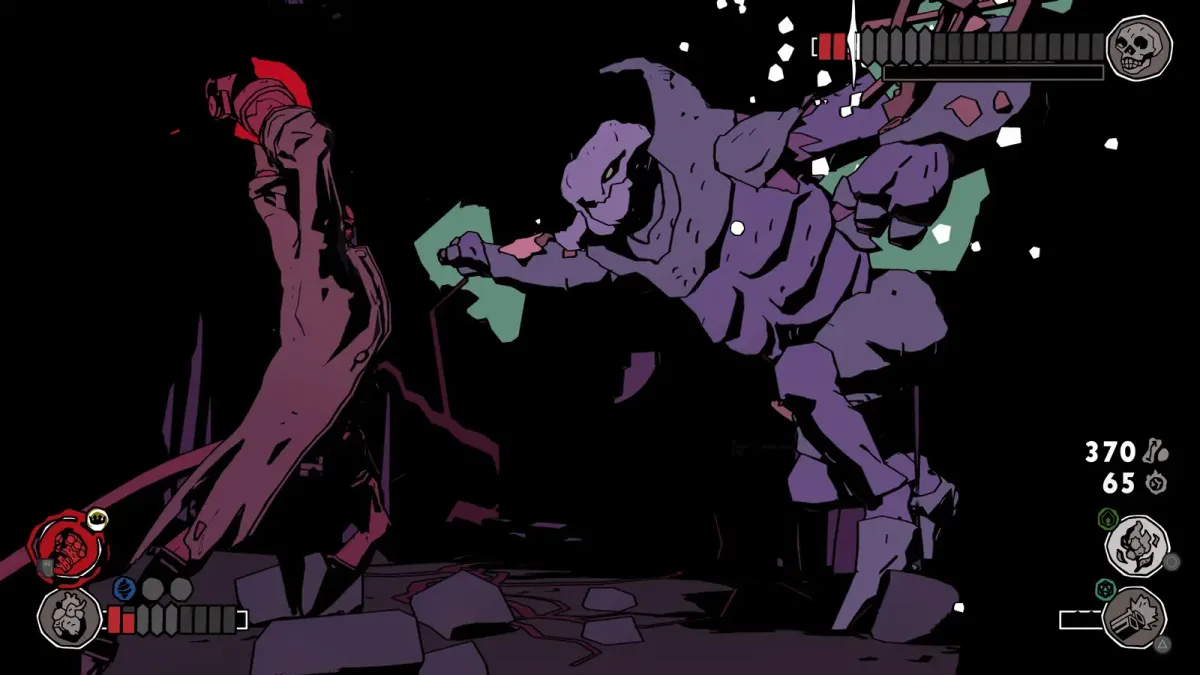
Shadows add depth by drawing attention to both what is and isn’t there. They emphasize the visible scraps of information while leaving hidden details up to your imagination. This technique breathes life into Mike Mignola’s art, and by extension, his creation Hellboy. Hellboy’s world leaves ample room for the monsters to lurk and for faces to say more than just what you can plainly see. You never know exactly what’s going on beneath the cover of shadows. Web of Wyrd takes advantage of Hellboy’s penchant for the unknown by placing him in a randomly generated world. While the premise fits Hellboy conceptually, the execution shines a little more light on the limitations lurking in the shadows than it should.
Web of Wyrd takes place in the titular Wyrd, a chaotic dimension filled with monsters from throughout storytelling history. In gameplay terms, this translates to Hellboy navigating through randomly generated mazes while fighting off monsters and spouting off insults. The layout changes each time you begin a “run” through a world, so mastery of the core game mechanics matters more than your ability to memorize the game as a whole. Stepping into the unknown with only your grit and your fists (and perhaps a firearm of your choice) is about as Hellboy as it gets, so the premise creatively captures the character’s essence with its unexpected choice of game style.
Speaking of style, the visuals also capture Hellboy’s essence. Web of Wyrd translates Hellboy’s shadowy aesthetic into the third dimension strikingly well. Moment-to-moment, the game often feels like an animated, breathing version of the comic book stories that inspired the game. The aesthetics immediately catch your eye and do a lot of the heavy lifting in terms of drawing you into Hellboy’s world. It looks cool!
Unfortunately, the game itself doesn’t live up to what the visuals convey. While the heavy shadows imply depth, Web of Wyrd ends up being a rather shallow game. Simplicity isn’t bad on its own, but it clashes with the mystery-laden atmosphere of Hellboy. The random generation theoretically ensures that you won’t know what prowls behind every corner. After a run or two, you’ll get the gist.
The layouts of the Wyrd leave little to the imagination. Each level consists of small arena rooms connected by long, narrow corridors. The visuals imply an abstract, incomprehensible world. Once you realize how the game works, that impression quickly fades. Each room serves a specific function and you will only find specific things in them, whether that’s an enemy, a powerup, or nothing at all. Pretty concrete, pretty comprehensible. A world of shadows and randomization should keep you guessing. Instead, the Wyrd feels structured and tame.
Instead of any sense of discovery or foreboding, it falls on the combat mechanics to keep you engaged. Designated combat rooms will spawn a multitude of enemies in. Smaller enemies, referred to as mooks, barely matter. They are fodder that die easily and will barely damage Hellboy. In most cases you can ignore them, and instead focus on the “big bads,” where the nuance of the fighting comes into play.
Combat options are plentiful enough to build a solid foundation for the game. Hellboy can punch, shoot guns, and use magical “charms” with varying effects. In terms of defense, enemy attacks can be blocked, or with proper timing, dodged or parried. How you utilize these options, and more importantly which variations of them you choose to bring into battle, forms the main strategy of the game. There are three types of guns and charms, which while not a lot, do provide distinct advantages and disadvantages that make them worth trying out. A lot of the fun in Way of Wyrd’s combat comes from figuring out the particularly strong combinations.
Before you learn how to efficiently smash through the game, you’ll likely find yourself trying to engage with the game on fairer terms to your detriment. Although strong feedback when landing hits keeps battles an engaging spectacle, there are many unfortunate quirks to the combat design that transform the game’s seemingly solid foundation into something decidedly less stable.
The fate of the world rests on Hellboy’s shoulders in Web of Wyrd, and boy does he move like it. A slower, weighty approach to the controls makes sense to an extent. Hellboy’s design implies a sense of heftiness with his top-heavy body and rock-solid fist. As Hellboy casually jogs between narrow corridors, however, I wondered if this approach held the game back on a fundamental level.
Web of Wyrd conveys its protagonist’s cumbersome nature too heavily. The game follows Hellboy from an over-the-shoulder third person perspective, not unlike your average blockbuster cinematic video game of choice. While this perspective provides for a lot of cool visuals, it isn’t ideal for the type of game it wants to be. Web of Wyrd is a brawler game all about fighting bad guys at heart, yet the controls of the game do not fully rise up to the demands of its inherently arcade-y nature. The close-up camera hinders your ability to read the environments and surrounding enemies, while the more cinematic approach to the animations makes the game slow and imprecise.
There exists what I can only describe as a “delay” to the controls that will sometimes result in unwanted or mistimed actions. Hellboy won’t always immediately respond to your command, which can lead to you pressing a button more than once, which the game will then store up and unleash even when you no longer want to do it. This happened a lot while firing a gun. I often pressed the button twice only intending to fire it once, but the game stored both inputs and made me waste an extra bullet. You can adjust to this odd quirk when fights are one-on-one. Anything more chaotic than that, and things start to feel downright bad.
Each level introduces new enemy types, yet they all end up feeling similar. They’ll throw out attacks that you need to block or dodge and then you beat on them until they die. The patterns differ, they just don’t make a huge difference. Individually, most enemies aren’t that tough. Things only become truly dangerous when two “big” enemies attack you in close proximity, which spells disaster for your camera perspective. Your strategy will often revolve around separating out enemies or focusing on ways to quickly dispose of one before they can team up. Efficient play becomes key to surviving particularly nasty combinations.
Of all of the fighting mechanics, the developers likely intended for you to use the dodge the most. The game limits your ability to block and parry through a “Toughness” meter, incentivizing you to focus on dodging and following up with counter hits. While that’s all well and good, I found that I never actually wanted to use the dodge despite the benefits.
Not only does dodging suffer from the pitfalls of the dreaded “delay,” it’s just not a particularly intuitive mechanic. Hellboy can move left or right, or he can jump back or crouch forward. You’re supposed to pick the type of dodge you do based on the enemy’s wind-up attack animation. In practice, most wind-ups do a poor job of conveying exactly how the game wants you to respond. Often the only way to really know how to dodge correctly is to guess or figure it out through a process of elimination after getting slapped around enough. Less often, you’ll dodge correctly only for the enemy to suddenly autocorrect at the last second and decide to hit you anyway. Sometimes this happens and sometimes it doesn’t. Either way, I don’t enjoy taking the gamble.
Frankly, the combat works better the less that you need to engage with its nuances. If you go into a run with the right equipment and stumble upon the right power ups, you can make short work of just about every enemy in the game. I highly recommend the powerup that lets you freeze enemies in place and the one that increases your damage the more consecutive hits you land – well I would, but the game ultimately decides what you’ll get. Cap off one of your supercharged beat downs with the grenade launcher and you’re basically unstoppable. There’s a tough robot enemy that you’ll fight roughly a million times by the end of the game, and stun-locking it while shredding through its health with your cheap powerups is the most rewarding part of the game by far.
Games like Web of Wyrd tend to encourage you to play through multiple times with their difficulty. That certainly seems to be the plan here as randomized powerups and the ability to upgrade your abilities in between runs will help even the odds. Truthfully, however, I didn’t start dying until the final stretch of the game, and even then I prevailed after a handful of attempts. Upgrades don’t majorly change your approach and the powerup pool is small enough that you’ll likely encounter the same ones on subsequent playthroughs. The game does not provide enough of a challenge or a diverse enough variety of powerups to keep you replaying the game.
In fact, despite the inconsistent fighting mechanics, the only times Web of Wyrd truly frustrated me were entirely unintentional. The Wyrd plays host to a variety of horrifying creatures and the most horrifying of them all may be the bugs running rampant. Some aren’t a big deal – visuals will occasionally not load in properly or a voice line won’t play as intended. Those are just to lull you into a false sense of security.
Sadly, some truly terrifying ones threaten to end your run altogether. One of the randomly generated mazes I encountered appeared to be completely impossible to finish – my only path forward was blocked and I could find no alternatives. I only encountered one area in the entire game where I had this problem, so I doubt I missed anything. Another time, I completed an area only for Hellboy to get stuck falling into an infinite loop, never reaching the next level. Although you never lose out on too much time when the game unceremoniously pulls the rug out from under you, that is cold comfort when the possibility it could happen at all sticks in the back of your mind.
By the time I reached the end of the story, I felt like I really had escaped from an endlessly looping hellscape. A lot of these comic book games value making you feel like the character – just probably not like this. After finishing the story, Web of Wyrd hopes you’ll return to experience more of its randomized level design and powerups. It even adds additional difficulty modifiers in the post-game to incentivize further replays. Sadly, I had no desire to go back.
I did anyway just to be thorough, but telling you that makes for a less dramatic paragraph.
Web of Wyrd tragically fails to live up to its shadowy nature. An obvious love for Hellboy and the world he inhabits shines through its fantastic visuals and the playful conversations you can engage in between your runs. While that light shines brightly, it also by comparison reveals the barebones, inconsistent experience lurking beneath its strong aesthetic.
Hellboy Web of Wyrd
Mediocre
Web of Wyrd’s shadow-heavy visuals perfectly capture the Hellboy aesthetic. Sadly, the game lurking beneath those shadows suffers from unambitious design, inconsistent mechanics, and occasionally devastating bugs. Fun can still be found in the Wyrd, it’s just harder to find than it should be.
Pros
- Shadow-heavy aesthetic perfectly captures the Hellboy look
- Combat can be fun at its most basic level
- Creative genre pick for Hellboy
- Lots of love for the source material
Cons
- Uninteresting level layouts
- Inconsistent, weighty combat mechanics
- Randomization not engaging enough for replays
- Formidable, run-ending bugs

